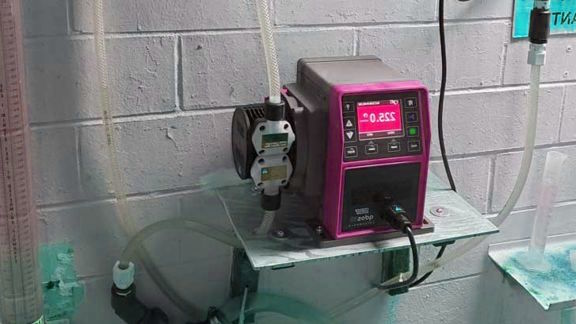Protolysis (from proton and Ancient Greek λύσις lýsis “solution, dissolution, termination”) (or primary reaction) is a chemical reaction in which a proton (H + ion) is transferred between two reactants. However, the term protolysis basically means the separation of protons. Because of this confusing conceptual similarity to hydrolysis or photolysis, IUPAC recommends avoiding the term, preferring to speak of proton transfer instead.
According to Bronsted’s important acid-base theory, proteolysis is a vital process. An acid then transfers a proton (H + ) to a reactant. A compound called an acid acts as a proton donor (proton donor), a base (usually water) accepts protons and is therefore called a proton acceptor. A chemical equilibrium is established between the reactants.

Protolytic reactions
If hydrogen chloride gas (HCl) enters water, hydrochloric acid is formed under proteolysis. In this equilibrium reaction, HCl molecule and H 3 O + ion are proton donors, that is, acids according to Bronsted. H 2 O and Cl- act as proton acceptors, so according to Bronsted they are open.
- H2O + Hsil ⇌ H3O+ + Sil- .
For example, if pure acetic acid (H3C-COOH) is added to water, H3O+ and acetate anion (H3C-COO-) are formed under proteolysis. Here CH3COOH and H3O + are proton donors, while H3C – COO- and H2O are proton acceptors.
- H3C-COOH + H2O ⇌ H3C-COO- + H3O+
Protolysis of the diprotic compound of sulfuric acid in water:
- H2SO4 + 2 H2O ⇌ H3O+ + H2O + HCSO4- ⇌ 2 H3O+ + SO42-
In this reaction equation, H 2 SO 4 molecules and H 3 O + ions are proton donors, that is, acids according to Bronsted. H 2 O and SO 4 2- act as proton acceptors, so according to Bronsted they are open. HSO4- plays a special role, because depending on the direction of the reaction, it can react as a proton acceptor or a proton donor. Materials with such properties are called ampholytes.
If ammonia gas (NH 3 ) enters water, ammonium ions (NH 4 + ) and hydroxide ions (OH – ) are formed. The proton donors here are NH 4 + and H 2 O, while OH- and NH 3 are proton acceptors.
- Nach3 + H2O⇌ Nach4+ + OH-
Autoproteolysis
Pure water is subject to what is known as autoproteolysis (also autodecomposition). It produces oxonium ion (H 3 O + ) and hydroxide ion (OH – ). H 2 O can react as a proton donor (as an acid) or as a proton acceptor (as a base). Therefore, it is also called ampholyte.
- 2 H2O ⇌ H3O+ + OH-
The balance is very much on the side of the water. The ion product of this reaction is approximately 10-14 mol 2 l-2 at 298 K (25 °C). Autoprotolysis of water is the reason why even chemically pure water has at least a low electrical conductivity. An application of autoprotolysis for separation of electrical charge can be found in the Kelvin generator when operating with chemically pure water.
Autoproteolysis (and therefore pH value) is strongly dependent on temperature. Ionic products of water (in mole 2 liter-2) are:
| Temperatures _ |
K w /10 −14 M 2 [3] [4] |
pK w [3] [4] |
Neutral pH |
|---|---|---|---|
| 0 degrees Celsius | 0.11 | 14.94 | 7.47 |
| C | 0.29 | 14.53 | 7.27 |
| C | 0.68 | 14.17 | 7.09 |
| C | 1.01 | 2:00 p.m | 7.00 |
| C | 1.47 | 13.83 | 6.92 |
| C | 2.92 | 13.53 | 6.77 |
| C | 5.47 | 13.26 | 6.63 |
| C | 9.6 | 13.02 | 6.51 |
| C | 16 | 12.80 | 6.40 |
| C | 25 | 12.60 | 6.30 |
| C | 37 | 12.43 | 6.22 |
| 100 degrees Celsius | 54 | 12.27 | 6.14 |
Water autoproteolysis model
Autoproteolysis of water is considered as follows:
H2O ⇌ H+ + OH-
The forward reaction, i.e. dissociation, formally leads to zero-order reaction. The reverse reaction is formally a second order reaction.
Autoproteolysis in non-aqueous solutions
In Bronsted acid-base reactions, in addition to water, other polar solvents can act as reactants, for example methanol or ethanol. A good example is the autoproteolysis of liquid ammonia. Ammonium and amide ions are formed.
- 2 notch3 ⇌ notch4+ + notch2-
Product ion = 10-32
Similar reactions are also known in concentrated sulfuric acid:
- 2 H2SO4 ⇌ H3SO4+ + HCO4-
Ion product = 10-4
Likewise for hydrogen fluoride:
- 3 holes ⇌ H2F+ + H2F-
Product ion = 10-10.7 (0°C)
(More examples under ampholytes # examples of ampholytes.)








